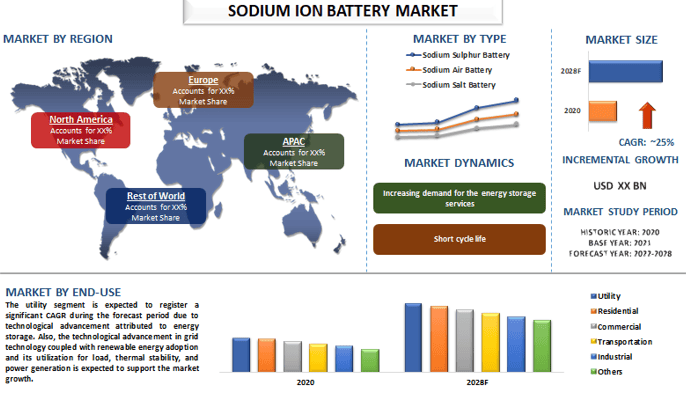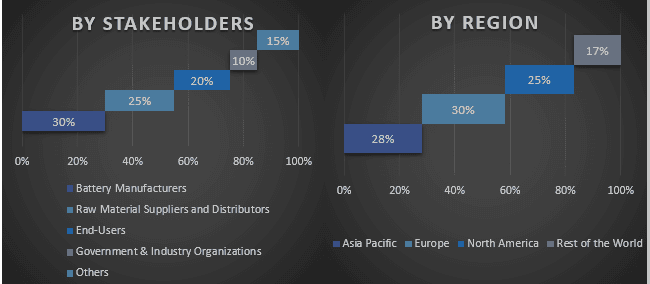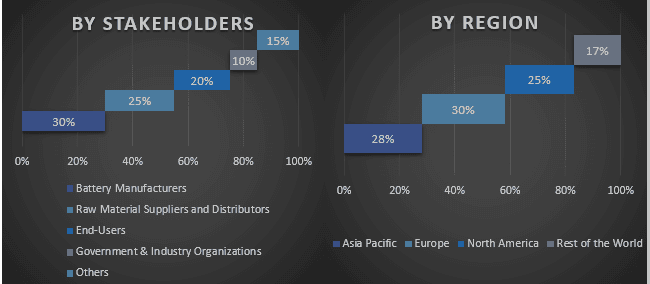Sodium Ion Battery Market: Current Analysis and Forecast (2022-2028)
Emphasis on Type (Sodium-Sulfur Battery, Sodium-Air Battery, and Sodium Salt Battery); End-Use (Utility, Residential, Commercial, Transportation, Industrial, and Others); and Region/Country

Global Sodium Ion Battery Market is expected to grow at a significant rate of around 25% during the forecast period. Sodium-ion batteries are energy storage device which is based on electrochemical charging & discharging reactions between the cathode and anode. The cathode electrode is generally made up of sodium-containing layered material. Due to their greater energy storage capacity, reduced price, and increased thermal stability, sodium-ion batteries have recently experienced substantial demand. In addition, sodium-ion batteries are more suited for static applications than Li-ion batteries since they have a similar battery life cycle and energy density. Additionally, the market for sodium-ion batteries is expected to rise in the future due to the rising need for energy and electricity, the increased use of renewable energy sources, and the incorporation of sodium-ion batteries in solar PV panels and wind energy technology.
AMTE Power Plc., NGK Insulators, HiNa Battery Technology, Aquion Energy, NEI Corporation, Nanode Battery Technologies, Contemporary Amperex Technology Co., Limited, Reliance Industries, Altris AB, and Natron Energy Inc. are some of the key players in the market. Several M&As along with partnerships have been undertaken by these players to facilitate customers with hi-tech and innovative products/technologies.
Insights Presented in the Report
“Amongst type, sodium-sulfur segment to witness significant growth during the forecast period”
Based on the type, the market is segmented into sodium-sulfur batteries, sodium-air batteries, and sodium-salt batteries. The sodium-sulfur segment is expected to witness significant market growth during the forecast period owing to its increasing adoption in the electric vehicle segment. Additionally, sodium sulfur batteries are frequently used on the island for high-value applications such as the integration of wind generation and distributed grid assistance since they can operate at higher temperature ranges and offer additional benefits over their counterpart batteries.
“Amongst end-use, the utility to hold a significant CAGR in the market in 2020”
Based on end-use, the market is segmented into utility, residential, commercial, transportation, industrial, and other. The utility segment is expected to register a significant CAGR during the forecast period due to technological advancement attributed to energy storage. Additionally, the adoption of renewable energy and its application for load, thermal stability, and power generation, along with rising energy demand, are likely to drive the market’s expansion. Additionally, the market for sodium-ion batteries for utility applications will be driven by rigorous government regulations to minimize the carbon impact and rising consumer awareness of cleaner fuel.
“North America to hold a significant share in the market”
In 2020, North America held a significant share of the global sodium ion battery market. This is mainly attributed to the increasing adoption of renewable energy including wind power, and solar energy, along with growing investment for the upgradation of grid infrastructure. Additionally, during the forecast period, the regional government’s plans to increase renewable energy capacity are expected to stimulate market demand for sodium-ion batteries. For instance, according to the IEA total installed capacity for solar and wind energy was 61 GW and 132 GW respectively for the year 2021 and is expected to reach 106 GW for solar and 148 GW for wind energy by 2023.
Reasons to buy this report:
- The study includes market sizing and forecasting analysis validated by authenticated key industry experts.
- The report presents a quick review of overall industry performance at one glance.
- The report covers an in-depth analysis of prominent industry peers with a primary focus on key business financials, product portfolio, expansion strategies, and recent developments.
- Detailed examination of drivers, restraints, key trends, and opportunities prevailing in the industry.
- The study comprehensively covers the market across different segments.
- Deep dive regional level analysis of the industry.
Customization Options:
The global sodium ion battery market can further be customized as per the requirement or any other market segment. Besides this, UMI understands that you may have your own business needs, hence feel free to connect with us to get a report that completely suits your requirements.
Table of Contents
1. Market Introduction
- Market Definitions
- Main Objective
- Stakeholders
- Limitation
2. Research Methodology Or Assumption
- Research Process of the Sodium Ion Battery Market
- Research Methodology of the Sodium Ion Battery Market
- Respondent Profile
3. Market Synopsis
- Market Synopsis
4. Executive Summary
- Executive Summary
5. Impact Of Covid-19 On The Sodium Ion Battery Market
- Impact Of Covid-19 On The Sodium Ion Battery Market
6. Sodium Ion Battery Market Revenue (usd Bn), 2020-2028f
- Sodium Ion Battery Market Revenue (usd Bn), 2020-2028f
7. Market Insights By Type
- Sodium Sulphur Battery
- Sodium Air Battery
- Sodium Salt Battery
8. Market Insights By End-use
- Utility
- Residential
- Commercial
- Transportation
- Industrial
- Others
9. Market Insights By Region
- North America
- U.S.
- Canada
- Rest of North America
- Europe
- Germany
- U.K.
- France
- Italy
- Spain
- Rest of Europe
- Asia-Pacific
- China
- Japan
- India
- Rest of Asia-Pacific
- Rest of World
- North America
10. Sodium Ion Battery Market Dynamics
- Market Drivers
- Market Challenges
- Impact Analysis
11. Sodium Ion Battery Market Opportunities
- Sodium Ion Battery Market Opportunities
12. Sodium Ion Battery Market Trends
- Sodium Ion Battery Market Trends
13. Demand And Supply-side Analysis
- Demand Side Analysis
- Supply Side Analysis
14. Value Chain Analysis
- Value Chain Analysis
15. Competitive Scenario
- Competitive Landscape
- Porters Fiver Forces Analysis
- Competitive Landscape
16. Company Profiled
- AMTE Power Plc.
- Contemporary Amperex Technology Co., Limited
- Nanode Battery Technologies
- NGK Insulators
- HiNa Battery Technology
- Aquion Energy
- NEI Corporation
- Natron Energy Inc.
- Reliance Industries
- Altris AB
17. Disclaimer
- Disclaimer
Research Methodology for the Sodium Ion Battery Market Analysis (2022-2028)
Analyzing the historical market, estimating the current market, and forecasting the future market of the global sodium ion battery market were the three major steps undertaken to create and analyze the adoption of sodium-ion batteries in major regions globally. Exhaustive secondary research was conducted to collect the historical market numbers and estimate the current market size. Secondly, to validate these insights, numerous findings and assumptions were taken into consideration. Moreover, exhaustive primary interviews were also conducted, with industry experts across the value chain of the global Sodium Ion Battery market. Post assumption and validation of market numbers through primary interviews, we employed a top-down/bottom-up approach to forecasting the complete market size. Thereafter, market breakdown and data triangulation methods were adopted to estimate and analyze the market size of segments and sub-segments of the industry pertains to. Detailed methodology is explained below:
Analysis of Historical Market Size
Step 1: In-Depth Study of Secondary Sources:
Detail secondary study was conducted to obtain the historical market size of the sodium ion battery market through company internal sources such as annual reports & financial statements, performance presentations, press releases, etc., and external sources including journals, news & articles, government publications, competitor publications, sector reports, third-party database, and other credible publications.
Step 2: Market Segmentation:
After obtaining the historical market size of the sodium ion battery market, we conducted a detailed secondary analysis to gather historical market insights and share for different segments & sub-segments for major regions. Major segments are included in the report as type and end-use. Further country-level analyses were conducted to evaluate the overall adoption of testing models in that region.
Step 3: Factor Analysis:
After acquiring the historical market size of different segments and sub-segments, we conducted a detailed factor analysis to estimate the current market size of the sodium ion battery market. Further, we conducted factor analysis using dependent and independent variables such as various types and end-use of sodium-ion batteries. A thorough analysis was conducted for demand and supply-side scenarios considering top partnerships, mergers and acquisitions, business expansion, and product launches in the sodium ion battery market sector across the globe.
Current Market Size Estimate & Forecast
Current Market Sizing: Based on actionable insights from the above 3 steps, we arrived at the current market size, key players in the global sodium ion battery market, and market shares of the segments. All the required percentage shares split, and market breakdowns were determined using the above-mentioned secondary approach and were verified through primary interviews.
Estimation & Forecasting: For market estimation and forecast, weights were assigned to different factors including drivers & trends, restraints, and opportunities available for the stakeholders. After analyzing these factors, relevant forecasting techniques i.e., the top-down/bottom-up approach were applied to arrive at the market forecast for 2028 for different segments and sub-segments across the major markets globally. The research methodology adopted to estimate the market size encompasses:
- The industry’s market size, in terms of revenue (USD) and the adoption rate of the sodium ion battery market across the major markets domestically
- All percentage shares, splits, and breakdowns of market segments and sub-segments
- Key players in the global sodium ion battery market in terms of products offered. Also, the growth strategies adopted by these players to compete in the fast-growing market
Market Size and Share Validation
Primary Research: In-depth interviews were conducted with the Key Opinion Leaders (KOLs) including Top Level Executives (CXO/VPs, Sales Head, Marketing Head, Operational Head, Regional Head, Country Head, etc.) across major regions. Primary research findings were then summarized, and statistical analysis was performed to prove the stated hypothesis. Inputs from primary research were consolidated with secondary findings, hence turning information into actionable insights.
Split of Primary Participants in Different Regions

Market Engineering
The data triangulation technique was employed to complete the overall market estimation and to arrive at precise statistical numbers for each segment and sub-segment of the global sodium ion battery market. Data was split into several segments & sub-segments post studying various parameters and trends in the areas of type and end-use in the global sodium ion battery market.
The Main Objective of the Global Sodium Ion Battery Market Study
The current & future market trends of the global sodium ion battery market were pinpointed in the study. Investors can gain strategic insights to base their discretion for investments on the qualitative and quantitative analysis performed in the study. Current and future market trends determined the overall attractiveness of the market at a regional level, providing a platform for the industrial participant to exploit the untapped market to benefit from a first-mover advantage. Other quantitative goals of the studies include:
- Analyze the current and forecast market size of the sodium ion battery market in terms of value (USD). Also, analyze the current and forecast market size of different segments and sub-segments
- Segments in the study include areas of type and end-use.
- Define and analysis of the regulatory framework for the sodium ion battery
- Analyze the value chain involved with the presence of various intermediaries, along with analyzing customer and competitor behaviors of the industry.
- Analyze the current and forecast market size of the sodium ion battery market for the major region.
- Major countries of regions studied in the report include Asia Pacific, Europe, North America, and the Rest of the World.
- Company profiles of the sodium ion battery market and the growth strategies adopted by the market players to sustain in the fast-growing market
- Deep dive regional level analysis of the industry

You can also purchase parts of this report. Do you want to check out a section wise
price list?
Related Reports
Customers who bought this item also bought










